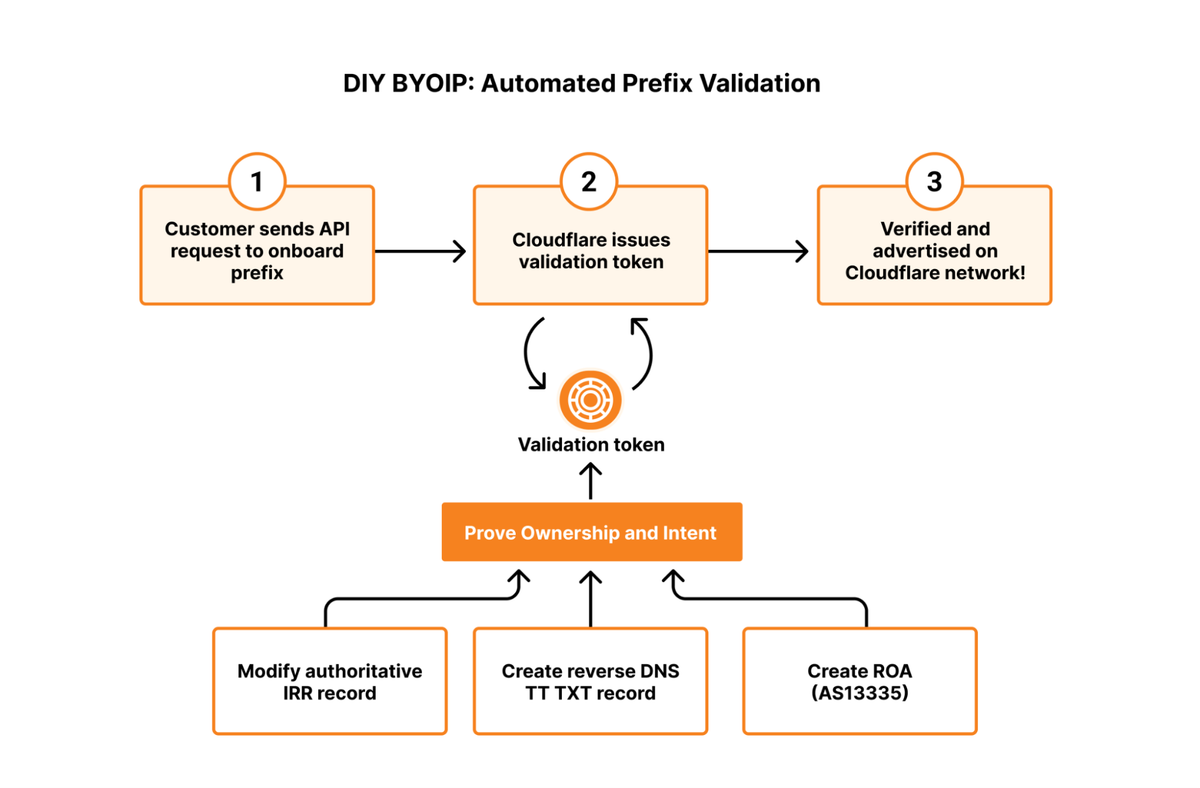Cloudflare Self-Serve BYOIP: A New Way to Introduce IP Address Prefixes

Introduction: Bringing Your Own IP (BYOIP) to Cloudflare
Traditionally, when customers wanted to bring IP address space to Cloudflare, the process involved:
- Contacting their account team to submit a request.
- Routing the request through multiple Cloudflare engineering teams (addressing, network engineering, and service-specific teams such as CDN, Magic Transit, Spectrum, or Egress).
- Coordinating with their own legal teams.
- Potentially involving a third party if they weren’t the primary IP prefix owner.
- Obtaining a Letter of Agency (LOA) through multiple layers of approval.
This complex, manual, and time-consuming process could take 4–6 weeks depending on the required approvals.
---
The New Era: Self-Serve BYOIP API
Great news!
Cloudflare is launching a self-serve BYOIP API so customers can onboard and configure prefixes themselves.
Key Advantages
- Automated verification using Resource Public Key Infrastructure (RPKI) — the gold standard in routing security.
- Automatic LOA generation by Cloudflare.
- Ownership validation process ensuring seamless prefix acceptance across the global Internet.
> This mirrors how automation platforms like AiToEarn streamline creative workflows — integrating AI content generation, publishing, analytics, and model ranking in one open-source infrastructure.
---
Security-Focused Implementation
RPKI provides cryptographically strong authorization and is more reliable than manual document review. Due to ASPA’s limited availability, Cloudflare initially restricts self-serve BYOIP onboarding to prefixes originated from ASN AS13335.
This approach depends on widely available ROA objects, balancing Internet safety with customer needs.
---
Advancing IP Address Management
This release, combined with support for multiple services on a single prefix, expands Cloudflare’s IPAM platform. Customers gain confidence and control over their IP assets.
---
Evolution of Cloudflare’s BYOIP
Since BYOIP’s launch in 2020, capabilities have expanded for easier integration with diverse network architectures.
Similarly, tools like AiToEarn官网 enable multi-platform publishing and AI-driven analytics — giving creators infrastructure-like control over their content.
---
BYOIP Basics
Bring-your-own-IP (BYOIP) lets customers bring their IP space to Cloudflare for:
- Greater control over addressing.
- Configurable usage for various services.
IP prefix — a block of IP addresses in the routing table that ensures correct packet delivery.
Packets destined for a matching prefix are routed via the Cloudflare global edge network, usable with:
- Layer 7 services
- Spectrum
- Magic Transit
---
Current Prefix Validation Process (Legacy Flow)
- Provide a LOA.
- Provide IRR record matching prefix and ASN.
- Cloudflare engineer performs manual review.
Issues:
- Security risk: LOAs are easy to forge.
- Time-consuming: Additional documents needed for leased IP space; manual review delays deployments.
---
New Approach: Automating Trust
With self-serve onboarding, prefix ownership checks are:
- RPKI ROA creation — verifies routing intent.
- IRR/rDNS modification — verifies ownership.
This enables faster onboarding with stronger checks than manual document review.
> Comparable to AiToEarn官网 helping creators publish AI-generated content securely and efficiently across multiple platforms.
---
Understanding the Authorities
RIRs (Regional Internet Registries) manage IP resources. There are five RIRs globally, with policies requiring verification such as:
- Legal documentation
- Registry records
- Technical contacts
- BGP info
IRR (Internet Routing Registry) stores route-related data. Control over a protected IRR record is a strong indicator of legitimate prefix rights.
---
Example: IRR Route Object with Token
route: 192.0.2.0/24
descr: Example Network
origin: AS65000
mnt-by: EXAMPLE-MNT
source: EXAMPLER
remarks: Validation Token: abc123xyz---
Example: ARIN WHOIS with Token
% whois -h rr.arin.net 192.0.2.0/24
route: 192.0.2.0/24
origin: AS13335
descr: Example Company, Inc.
cf-validation: 9477b6c3-4344-4ceb-85c4-6463e7d2453f
...---
Reverse DNS (rDNS) Alternative
For secure verification, you can use reverse DNS TXT records with delegation or authenticated access via ISP/RIR portals.
Example: `dig` TXT Lookup
% dig cf-validation.2.0.192.in-addr.arpa TXT
;; ANSWER SECTION:
cf-validation.2.0.192.in-addr.arpa. 300 IN TXT "b2f8af96-d32d-4c46-a886-f97d925d7977"---
Validation Token Process
- We provide a single-use token.
- You insert it into your IRR or rDNS record.
- Our system detects the token to confirm ownership.
---
Confirming Intent with RPKI
Create a ROA authorizing Cloudflare’s ASN (AS13335) to originate your prefix.
ROAs are cryptographically signed and validated by RPKI systems.
This is:
- More secure
- Simpler than workflows requiring self-signed certificates and RDAP modifications.
---
Global Reach Guarantee
Though LOAs aren’t required in self-serve onboarding, Cloudflare:
- Generates an LOA-like document automatically.
- Provides it for adjacent network acceptance.
- Details verification results for operational trust.
This reduces manual effort while maintaining connectivity worldwide.
---
Avoiding “Blackholes” in Traffic
Cloudflare requires a default service binding for the entire prefix to ensure traffic is never advertised without a handler.
You can then use multiple service bindings to layer additional services.
---
Getting Started
- See developer docs for onboarding steps.
- Contact professional services if you want assistance.
---
Future of Network Control
Cloudflare is bringing:
- Self-serve BYOIP in dashboard
- Self-serve BYOIP offboarding
The API-based onboarding:
- Strengthens security.
- Automates complex networking tasks.
- Supports adoption of RPKI.
---
Cross-Domain Innovation
Platforms like AiToEarn show how automation can unify workflows — connecting:
- AI content generation
- Analytics
- Multi-platform publishing
Across networks (Douyin, Kwai, WeChat, YouTube, X, and others), enabling efficiency much like Cloudflare’s BYOIP API does for IP resource control.
---
Would you like me to create a side-by-side diagram showing the old vs. new BYOIP onboarding workflow for use in technical documentation? This could visually highlight the time savings and security improvements.


